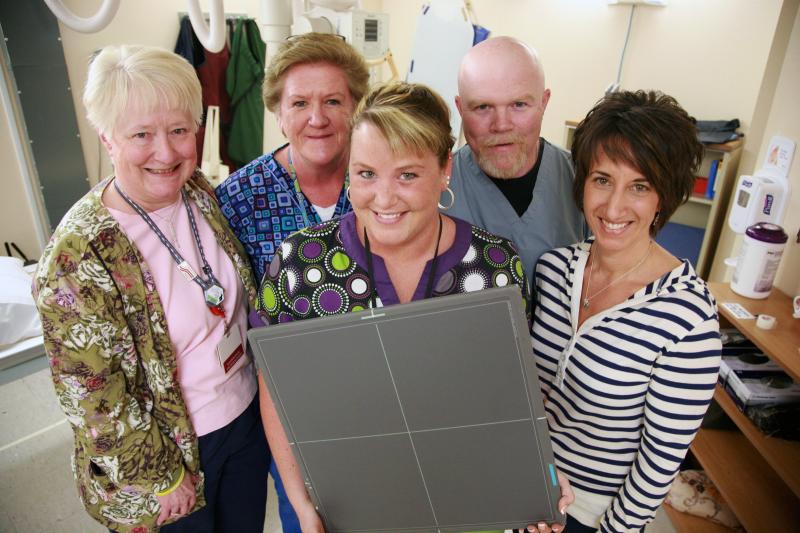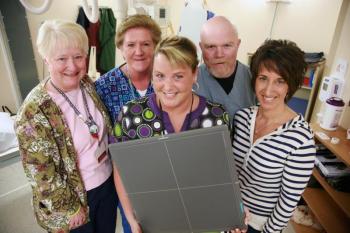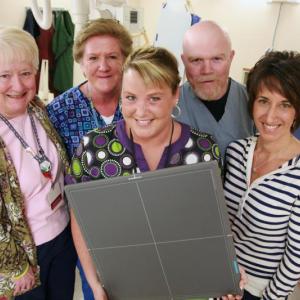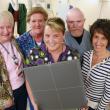New wireless digital imaging makes X-rays easier and safer
 Pictured are LincolnHealth Diagnostic Imaging staff members, from left: Lana Brandt, Mary Johnston, Jill Reynolds, Shane Creamer and Pam Hepburn. Jill Reynolds is holding a new wireless digital radiological sensor that makes getting an X-ray at the Miles Campus of LincolnHealth quicker, more convenient and safer. The new sensor also provides images that are as good as any in the state, even at much larger hospitals. Courtesy of LincolnHealth
Pictured are LincolnHealth Diagnostic Imaging staff members, from left: Lana Brandt, Mary Johnston, Jill Reynolds, Shane Creamer and Pam Hepburn. Jill Reynolds is holding a new wireless digital radiological sensor that makes getting an X-ray at the Miles Campus of LincolnHealth quicker, more convenient and safer. The new sensor also provides images that are as good as any in the state, even at much larger hospitals. Courtesy of LincolnHealth
 Pictured are LincolnHealth Diagnostic Imaging staff members, from left: Lana Brandt, Mary Johnston, Jill Reynolds, Shane Creamer and Pam Hepburn. Jill Reynolds is holding a new wireless digital radiological sensor that makes getting an X-ray at the Miles Campus of LincolnHealth quicker, more convenient and safer. The new sensor also provides images that are as good as any in the state, even at much larger hospitals. Courtesy of LincolnHealth
Pictured are LincolnHealth Diagnostic Imaging staff members, from left: Lana Brandt, Mary Johnston, Jill Reynolds, Shane Creamer and Pam Hepburn. Jill Reynolds is holding a new wireless digital radiological sensor that makes getting an X-ray at the Miles Campus of LincolnHealth quicker, more convenient and safer. The new sensor also provides images that are as good as any in the state, even at much larger hospitals. Courtesy of LincolnHealth
Over the past 28 years, Shane Creamer has seen X-ray technology make huge leaps in image quality. But a new wireless digital radiological detector at the Miles Campus of LincolnHealth may be the most meaningful shift yet for his patients.
The new technology is faster and provides much better images with less radiation than the system it replaces, which means patients are safer and spend less time in the X-ray room while doctors wait seconds instead of minutes for the images, which can be a critical difference during an emergency.
Because the digital sensor (a 17 by 17-inch plate that absorbs the X-rays after they pass through the body) can be removed as needed, it also eliminates the need to put the patient on a “bed” and makes it much less likely that they will have to hold uncomfortable poses.
The Miles Campus of LincolnHealth in Damariscotta was the first hospital in the area to acquire the technology, and while larger hospitals in southern Maine have it, said Lana Brandt, LincolnHealth director of diagnostic imaging, the new wireless system means her team can offer patients as good an image as they can get anywhere in the state, usually with less waiting and discomfort.
“We are very happy to be able to offer this,” Brandt said. Even more important than convenience for some patients is the added level of safety.
The new wireless sensor is much more sensitive than the one it replaces, which allows an average reduction of about 30 percent in the amount of radiation patients are exposed to and up to 80 percent in some cases.
Reducing the amount of radiation patients are exposed to during diagnostic tests is part of an initiative involving all MaineHealth hospitals. MaineHealth is the largest integrated healthcare network in Maine. Hospitals in the MaineHealth network include LincolnHealth and Maine Medical Center in Portland.
While the amount of radiation given off during a normal X-ray is relatively small, about the same as the amount of normal background radiation a patient would absorb in four days in the sun, the increased use of three dimensional computed tomography or CT scans, which take much more detailed images and give a larger dose of radiation, has increased awareness of the cumulative risk of radiation.
Creamer said that for some patients, those concerns have been enough to cause them to opt out of having an X-ray that might help with the diagnosis of a medical condition, like a painful shoulder. He said patients respond positively when they hear about the much smaller dose from the new machine.
Doctors have also commented that the new images offer a much clearer view of soft tissue and objects that might be hard to see with older technology. For example, Creamer said the new machine does a much better job finding glass, which might be associated with a car accident, than the machine it replaces.
Brandt said the introduction of the new technology is made possible by the support of the community. Charitable contributions from the public, as well as the Miles Hospital League and St. Andrews Auxiliary allow Lincoln County Healthcare to make equipment upgrades that improve safety and the level of care every year.
Event Date
Address
United States






















